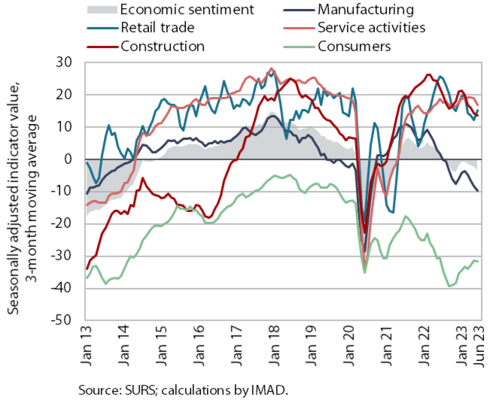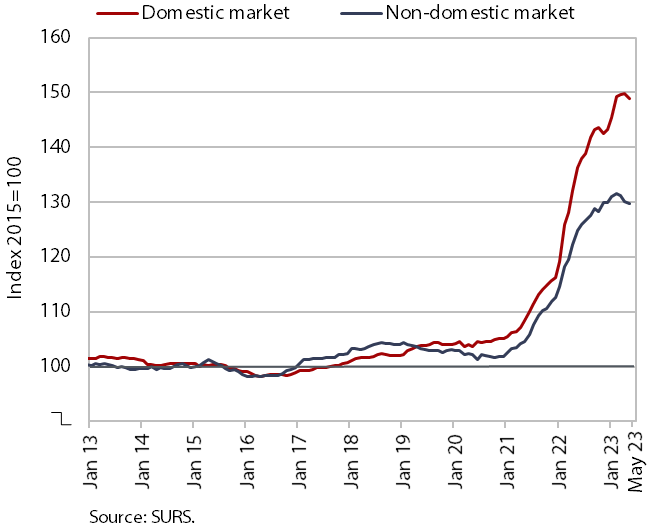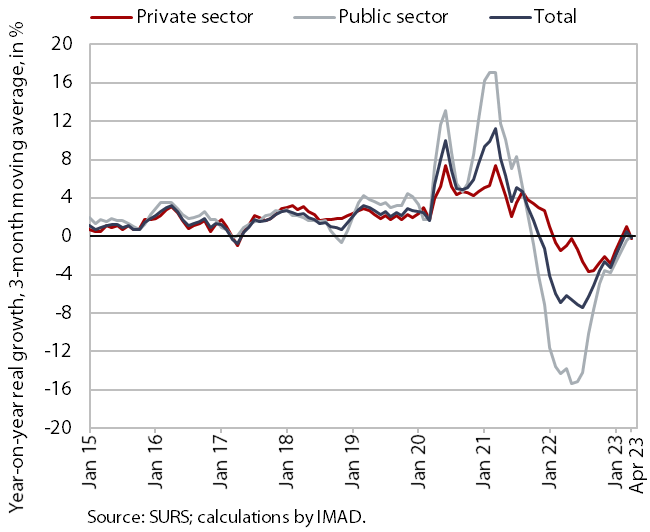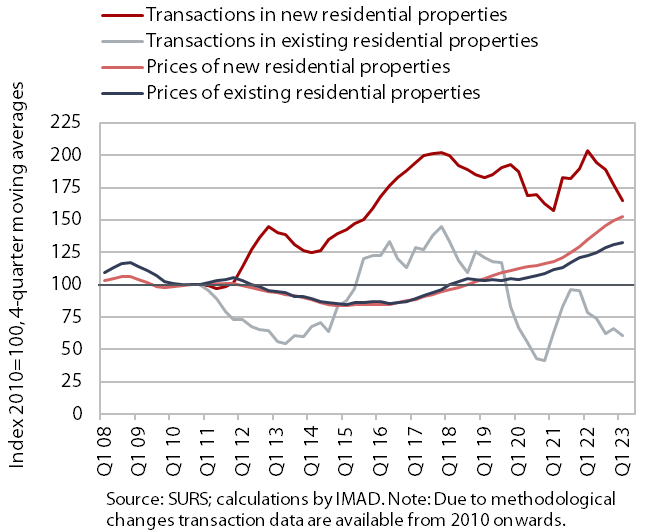Charts of the Week
Charts of the week from 19 to 23 June 2023: economic sentiment, slovenian industrial producer prices, average gross wage per employee and residential housing
The value of the economic sentiment indicator continued to decline in June. This reflects the negative contributions of confidence indicators in services and among consumers, and to some extent also in manufacturing and construction. Only in retail trade did the confidence indicator improve. The economic climate deteriorated in the second quarter on average compared to the first quarter, and sentiment also deteriorated significantly compared to the second quarter of last year. Slovenian industrial producer prices fell on average for the second month in a row in May, while year-on-year growth slowed noticeably on last year’s high base, reaching the lowest level since July 2021. The average gross wage fell by 0.4% year-on-year in real terms in April. In the private sector, it fell by 1.4% year-on-year in real terms, while in the public sector it rose by 1.6% in real terms, mainly due to the wage increase agreed last year. In the first quarter, growth of dwelling prices moderated further amid a further decline in the volume of sale.
Economic sentiment, June 2023

The sentiment indicator fell for the sixth consecutive month in June. Sentiment deteriorated by 1.8 p.p. month-on-month. This was due to the negative impact of confidence indicators in services and among consumers, and to some extent in manufacturing and construction. Only the contribution of the retail trade indicator was positive. After a gradual increase since the beginning of the year, consumer confidence fell in June for the first time this year. All indicator components deteriorated, especially households’ expectations about their financial situation. Enterprises in services report in particular a deterioration in their business situation, while those in manufacturing and construction still report a deterioration in order books, which is related to the uncertain economic situation and weak foreign demand. Compared to June last year, the value of the economic sentiment indicator fell by 5.4 p.p. Confidence was down in all activities, the most in manufacturing and among consumers. The economic climate also deteriorated on average in the second quarter compared to the first quarter, and sentiment also deteriorated significantly compared to the second quarter of last year.
Slovenian industrial producer prices, May 2023

Slovenian industrial producer prices fell on average month-on-month in May for the second month in a row (by 0.4%). The prices of intermediate goods and energy decreased, while prices of consumer goods increased slightly due to rising prices of durable goods. Compared to the previous month, prices were lower in both domestic and foreign markets. Year-on-year price growth moderated significantly in May to 6.6% (9.9% in April), the lowest level since July 2021. The higher base contributed significantly to the lower growth. Due to strong growth in the second half of last year and at the beginning of this year, energy prices still recorded the strongest year-on-year increase, rising by about one-fifth in May. Consumer goods prices rose by about a tenth, while prices of intermediate goods and capital goods increased by 3.2% and 5.5%, respectively.
Average gross wage per employee, April 2023

The average gross wage fell by 0.4% year-on-year in real terms in April. In the private sector, the average gross wage fell by 1.4% in real terms year-on-year. Growth was still strongest in accommodation and food service activities, which is facing a major labour shortage. Gross wages in the public sector increased by 1.6% year-on-year in real terms, mainly due to the last year’s agreement on wage increases. Compared to April last year, the average gross wage increased by 9% in nominal terms – by 11.1% in the public sector and by 7.8% in the private sector. In the first four months, the average year-on-year gross wage growth was modest in real terms – 0.2% (0.3% in the private sector and 0.1% in the public sector).
Residential housing – Q1 2023

Dwelling prices continued to grow slightly in the first quarter as the volume of sale continued to decline. Prices rose by 1.6% compared to the last quarter of last year and by 8.8% compared to the first quarter of 2022. The still high year-on-year growth was mainly due to higher prices of existing dwellings (by 9.1%), where the number of transactions was almost a quarter lower year-on-year and the lowest since the first quarter of 2021. Prices of newly built dwellings were also higher year-on-year (by 5%), but 8.4% lower than in the last quarter of 2022. The number of transactions, which make up only a small part of total sales (3%), also fell sharply year-on-year (by more than one-third).
